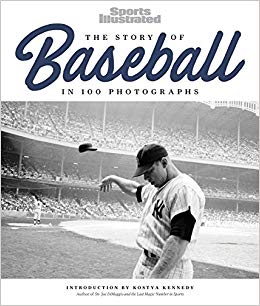
Visual beauty and compact history lessons greet the reader in The Story of Baseball: In 100 Photographs (Time Inc. Books; hardcover, $30; 224 pages). Picking merely 100 photos to tell the story of baseball is tough, but the editors of Sports Illustrated were judicious in their choice of photographs, particularly in the era before the magazine was founded in 1954.
The book is broken into five sections, with each chapter representing a different era of baseball. “Beginnings” covers the 50-year period from the first professional baseball team in 1869 until 1919. “From Ruth to Robinson” bookends the emergence of the lively ball championed by Babe Ruth and Jackie Robinson’s breaking of baseball’s modern color line in 1947.
“The Golden Years” covers the two-decade period from 1948 to 1968, and “Expanding Influence” ushers in the game’s expansion, labor strife and cherished records broken. Finally, “Wildness” covers the steroids era and the re-emergence of the New York Yankees and Boston Red Sox as baseball dynasties.
Every picture tells a story, and the one page of explainer type completes the visual.
There’s Christy Mathewson, Cy Young and Walter Johnson in classic pitching stances, and a photograph of the Holy Grail of baseball cards — the Honus Wagner T-206 tobacco card. Ty Cobb is sliding hard into third base and Babe Ruth is launching one of his 714 career home runs. Night baseball makes its debut and Cooperstown opens its doors.
A dying Lou Gehrig proclaims he is the luckiest man on the face of the earth, Joe DiMaggio and Ted Williams ooze grace and power, and Ralph Branca could not be consoled after allowing one of the game’s most famous home runs. Willie Mays made “The Catch,” Jackie Robinson dared pitchers and fielders to throw him out on the bases and Bill Mazeroski brought down the house in Pittsburgh.
The pictures showcase the smooth (Vin Scully behind the microphone) and the rough (Juan Marichal hitting John Roseboro over the head with a baseball bat), along with dignity (Roberto Clemente) and class (Hank Aaron). Carlton Fisk willing a home run in Game 6 of the 1975 World Series was dramatic, while Mark Fidrych and Fernando Valenzuela inspired crazes. Cal Ripken high-fived fans as he became baseball’s ironman, and Steve Bartman turned the Friendly Confines hostile when he reached for a foul ball during the 2003 NLCS.
And finally, there is the exhilarating moment when the Cubs won their first World Series in 108 seasons.
The black-and-white photos are stark and use shots from Charles Conlan, the Bain Collection from the Library of Congress (an archive of photographs archived by George Grantham Bain for his news service), the Bettmann Archive from Getty Images, the Life Picture Collection, the New York Daily News, The New York Times and the National Baseball Hall of Fame Library.
The subject matter also wanders away from the major leagues, with photos from the College World Series, the Negro Leagues and the All-American Girls Professional League.
Color photos tell wonderful stories, too. There’s Casey Stengel deep in thought, Fidel Castro going into his windup, the intensity of Bob Gibson as he follows through on the mound, and Pete Rose barreling into Ray Fosse at the plate to win the 1970 All-Star Game.
The Rose photo is taken from a different angle than baseball fans traditionally see, and what makes Herb Scharfman’s photo so compelling is the expression of Cubs manager Leo Durocher, who served as third-base coach. Durocher, fists balled and yelling, has a satisfied look as Rose scores the winning run. It’s the kind of play Durocher loved, and the photograph captures it perfectly.
Some of the photographs seem a little out of place, but since they are from the archives of Sports Illustrated the authors are at liberty to use them. For example, the story of Sidd Finch was fun, but it was a concocted one and the accompanying photograph does not really symbolize the story of baseball. At least, not to me.
However, the photo of an animated Ted Williams demonstrating hitting techniques to Wade Boggs and Don Mattingly at a restaurant in Clearwater during spring training is Sports Illustrated at its photographic best. And the photo of George Steinbrenner astride a horse and dressed as Napoleon is laugh-out-loud funny.
One of Sports Illustrated’s strengths through the years has been the ability to create compelling and relevant headlines to go with its photographs. This book showcases that ability, with short, punchy phrases. “A Master Stroke” is the headline for the photo of Wee Willie Keeler “hitting ’em where they ain’t.” “Bright Idea” heralds the first night game in major-league history, and “Taking it to the Streets” immortalizes stickball games, and “Inside Baseball” immortalizes the day the Astrodome opened in Houston.
Telling the story of baseball in 100 photographs is a daunting task, but the editors of Sports Illustrated are equal to the challenge.
 RSS Feed
RSS Feed
